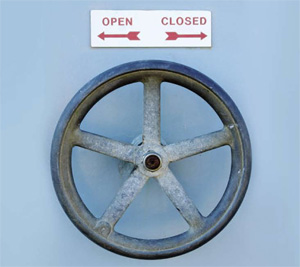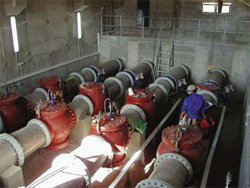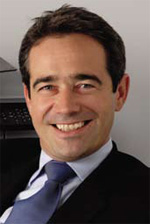What is the evaluation on the region’s market? The future outlook, Jose Franco reports, is mostly bullish, even as the world faces the threat of a second recession due to the debt turmoil in Europe.
What is the evaluation on the region’s market? The future outlook, Jose Franco reports, is mostly bullish, even as the world faces the threat of a second recession due to the debt turmoil in Europe.
 Its large number of industrial projects and efforts to localise the supply chain provide good growth potential for the Middle East’s valves and actuators market. This refers more likely to the 2012 scenario, however, when growth rates are expected to reach pre-downturn levels. The oncoming year can expect only slow to medium growth, owing to the continuing tight-credit situation and the scaling down of projects due to excess global capacities and low world demand.
Its large number of industrial projects and efforts to localise the supply chain provide good growth potential for the Middle East’s valves and actuators market. This refers more likely to the 2012 scenario, however, when growth rates are expected to reach pre-downturn levels. The oncoming year can expect only slow to medium growth, owing to the continuing tight-credit situation and the scaling down of projects due to excess global capacities and low world demand.
The future outlook is mostly bullish, nevertheless, even as the world faces the threat of a second recession due to the debt turmoil in Europe, according to research and consultancy firm, Frost & Sullivan. Industry experts believe so, as opportunities for valves, which control the flow or pressure of fluid, and actuators (which convert energy into motion) are guaranteed whenever and wherever the need to control, isolate or protect industrial processes arises.
For Tyco Valves & Controls, for example, the main growth opportunities with regard to its products lie in the oil and gas, construction and process industries, says Christophe Melinette. The managing director of Tyco Flow Control Middle East adds that these industries include HVAC&R and building services projects and large-scale applications, such as district cooling systems. He says the company’s operation in major industry sectors “enables us to apply our knowledge and experience to the Gulf market”.
O&G, NON-O&G
The Gulf Arab nations, particularly Saudi Arabia, will propel industry growth in the Middle East, whose industrial valves and actuators market is seen to earn $2 billion by 2016 from over $1.2 billion in 2009. And whilst future growth in this market will continue to depend largely on the oil and gas industry, large-scale infrastructure development and rapid industrialisation mean there is tremendous opportunity as well in the non-oil and gas market.
In a summary of its report, titled “Middle East Industrial Valves & Actuators Market”, Frost & Sullivan says other industrial sectors, such as power and water desalination, are seen to drive market development. The company’s research analyst, S Harsha Eashwer, stresses, “Numerous industrial city projects are currently under construction across various Middle East countries, as part of efforts to diversify the economy from oil and gas dependence, as well as to provide jobs to burgeoning populations.”
Egypt is a huge market as well, says Dubai-based Fadi Alameddine, Managing Director of FlowLine Controls, citing the country’s various ongoing and planned projects on waterworks, infrastructure, climate control and oil and gas. But he says it is mainly Saudi Arabia that will drive the industrial valves market, to feed the demand of its waterworks and other sectors involving oil and gas, food and dairy, pharma and petrochemicals.
“We’re increasing our investments in the region,” Alameddine says in an interview. Already, FlowLine has branches in Saudi Arabia and Qatar, had invested for a laboratory in Dubai and still wants to consider other gulf markets. “We haven’t had much time to look into Oman,” he stresses. “At this stage, we should be looking probably into Kuwait and Oman.”
Other markets in the rest of the Middle East (R-O-M-E), which had previously been shunted by investors, such as Iraq, may also present immense potential for market growth in the future. “These changes, along with changing commercial dynamics, could affect the competitive structure of the market, as companies from South Korea, India and China increase their local presence,” Frost & Sullivan says.
CHEAP VALVES
The study, which enumerates the other R-O-M-E countries it has covered as Iran, Yemen, Syria, Jordan and Lebanon, stresses it was the recent recession that facilitated the popularity of low-price valves in the Gulf and the wider Middle East region, as end-users have become sensitive to cost. Most of these inexpensive valves come from China and India.

Valves from FlowLine Controls
And the growing competition from low-cost valve and actuator companies is where the major near- to long-term issues will arise, Eashwer says. Other factors that will have significant effect upon current market dynamics are “the low impetus on oil exploration in Saudi Arabia due to the existing surplus, the moratorium on gas exploration in Qatar and the politico-economic instability in Iran and Iraq, amongst others”.
New market entrants that can address cost concerns may thrive, but still it is the most experienced and robust companies that are more prepared to adjust to market changes, Melinette says. “Ultimately, valves and actuators form critical components within many projects, requiring reliable products that offer reassurance and peace of mind,” he adds. “For many customers, support and guidance, particularly with regard to maintenance cost calculations and areas that less-established suppliers may not have the resources to fulfill, can be hugely important.”
The moratorium on Qatar’s further development of its vast North Field gas reservoir will not be lifted until at least 2013, when all the planned projects in the area will have brought on stream. The government said it had to study further on how to maximise gas production and, at the same time, preserve the reservoir for future generations.
Frost & Sullivan says that whilst Saudi Arabia will continue to be the largest valve market in the Middle East, the Qatari market is expected to grow rapidly, post-2013, owing to the projected growth in global demand for natural gas after 2012.
It also has the observation that the “addressable actuators market”, which was worth $260 million in 2009, accounted for a small share of the total Middle East vale and actuator demand, since most new project orders were placed with the international locations of suppliers. But there might be a shift in market behaviour.
“This trend is expected to change as the market grows, with end-users insisting on better regional presence and capabilities,” it says. “Companies would also attempt to gain a competitive advantage by tier local presence – as seen by the increase in local valve supplier representation over the past few years.”
The addressable actuators market accounts for new project and after-sales actuator demand met through international orders and local procurement. This also includes the demand met between divisions of a company. The non-addressable market refers to demand met from the internal production of actuators within the valve manufacturing company.
FAST VALVES
Whilst a consolidated customer base and the continuing efforts to reduce costs do, indeed, pose a major challenge to the industry, the need to produce innovative solutions is also a serious issue that begs for attention. “One major challenge is to find electric valves that are as accurate and fast as pneumatic valves,” Alameddine says. “The industry must also look for more green solutions. In other words, how do we add intelligence to actuators?”

Christophe Melinette
Melinette has the same opinion, saying, “Manufacturers must constantly work to maximise efficiency, maintain product quality and help their customers to achieve cost-savings.” Tyco works closely with its customers to address various challenges. “As a global manufacturer, we aim to share our expertise and knowledge with our local customers, and there are few suppliers that can offer this level of service.”
The innovations in materials and valve construction represent an opportunity for change, he says, since basic valve designs have not changed so much over time. Tyco’s CompoSeal valve, for instance, is made of composite materials that make it lighter and more cost-effective than traditional valves, making it an ideal solution for HVAC&R applications. “The biggest changes quite often take place within actuation and control systems, as the industry adapts to new technologies, such as wireless controls and valve monitoring,” he stresses.
Developments such as this have helped Tyco expand its range of services to offer, amongst other things, predictive maintenance solutions. Besides offering specialist site services, Tyco, being an original equipment manufacturer, uses its own engineers to maintain valves and control systems, including non-Tyco products.
“Our commitment to the Middle East market is reflected in both our financial performance and heritage throughout the area, and we look forward to developing our position across the region,” Melinette says. In 2009, Tyco generated 27%, or over $4.7 billion, of its earnings from operations in Europe, the Middle East and Africa.
Copyright © 2006-2025 - CPI Industry. All rights reserved.